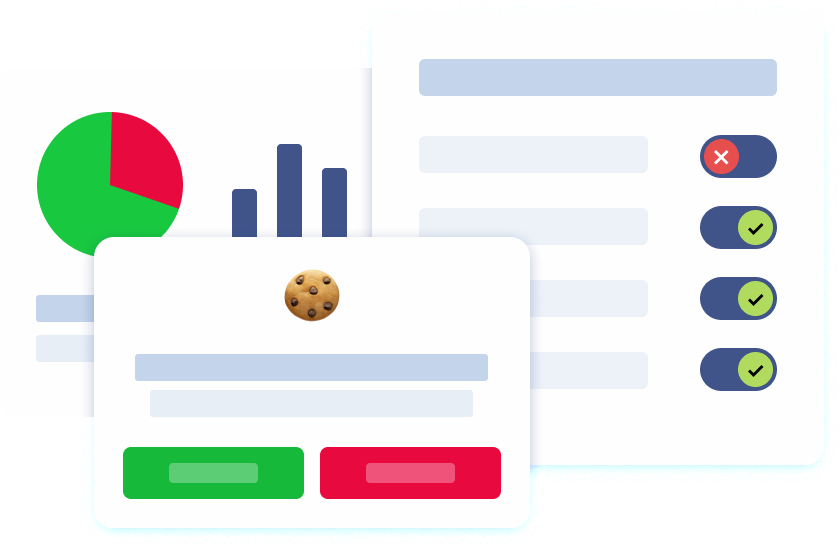Introduction
In today’s data-driven world, safeguarding personal information has become paramount. The General Data Protection Regulation (GDPR) is an extensive framework aimed at safeguarding the personal data of individuals within the European Union (EU). As we navigate through 2025, ensuring GDPR compliance remains crucial for organizations that collect, process, or store personal data of EU residents. Organizations must establish a valid legal basis to collect data and ensure their data collection practices are lawful under GDPR. This article provides an in-depth GDPR compliance checklist to guide businesses in adhering to data protection laws and maintaining the trust of their data subjects.
What is GDPR?
The General Data Protection Regulation (GDPR) is a robust data protection law that came into effect on May 25, 2018. It regulates the processing of individuals’ personal data within the EU, aiming to harmonize data protection laws across member states and empower individuals with greater control over their personal information. GDPR applies to any organization, regardless of its location, that offers goods or services to or monitors the behavior of EU residents. This extraterritorial scope means that businesses worldwide must ensure they handle personal data in compliance with GDPR mandates.
GDPR Requirements
As organizations continue to navigate the complex landscape of data protection, understanding and adhering to GDPR requirements is paramount. The General Data Protection Regulation establishes a comprehensive set of rules that govern how personal data is collected, processed, and stored within the European Union. These requirements are designed to bolster data privacy and security, ensuring that data subjects’ rights are respected and protected. For businesses, compliance with GDPR is not just a legal obligation but a crucial step towards building trust with customers and safeguarding sensitive information. Organizations must fulfill key GDPR requirements to remain compliant in 2025 and beyond.
Purpose Limitation and Data Minimization
Under GDPR, organizations must collect personal data for specific, explicit, and legitimate purposes. This principle of purpose limitation ensures that data is not processed in a manner incompatible with the initial reasons for its collection. For instance, if personal data is collected to process an online purchase, it should not be used later for unrelated marketing activities without obtaining additional consent from the data subject.
Data minimization complements this by mandating that only personal data necessary for the intended purpose is collected. Organizations should evaluate their data collection practices to ensure they are not gathering excessive information. Additionally, it is crucial to classify and document all the personal data collected and processed to ensure compliance with GDPR. This includes identifying special categories of data, documenting processing purposes, and data recipients. By limiting data collection to what is essential and documenting all the personal data, businesses reduce the risks associated with data breaches and enhance their compliance posture.
Storage Limitation and Integrity
GDPR requires organizations to retain personal data only for as long as necessary to fulfill the purposes for which it was collected. Once the data is no longer needed, it should be securely deleted or anonymized. Implementing clear data retention policies helps in managing the lifecycle of personal data and ensures compliance with storage limitation principles.
Maintaining data integrity and confidentiality is also paramount. Organizations must implement suitable technical and organizational measures to safeguard collected data from unauthorized access, modification, or destruction. This includes using encryption, access controls, and regular security assessments throughout its lifecycle.
Data Protection Officer (DPO)
Appointing a Data Protection Officer (DPO) is mandatory for organizations whose core activities involve large-scale processing of sensitive data or regular and systematic monitoring of data subjects. Data controllers hold significant responsibilities under the GDPR, including the necessity to report data breaches promptly to the relevant authorities and maintain records of their data processing activities. The DPO is tasked with managing data protection strategies and ensuring adherence to GDPR requirements. They serve as the point of contact between the organization and data protection authorities, providing guidance on data protection impact assessments and monitoring data processing activities.
The DPO should operate independently, without any conflict of interest, and report directly to the highest level of management. This independent reporting structure ensures that data protection considerations are integrated into the organization’s decision-making processes.
Data Subject Rights
GDPR grants individuals several rights concerning their personal data:
Right of Access: Data subjects have the right to inquire if their personal data is being processed and, if so, to access that data along with details about the processing activities.
Right to Rectification: Individuals have the right to request the correction of inaccurate personal data or the completion of incomplete data.
Right to Erasure (“Right to be Forgotten” ): Data subjects have the right to request the deletion of their personal information under specific circumstances, such as when the data is no longer necessary for the purpose it was originally collected for or if they choose to withdraw their consent.
Right to Restriction of Processing: Individuals can request the limitation of data processing under specific conditions, for example, if they contest the accuracy of the data.
Right to Data Portability: Individuals are entitled to obtain their personal information in a format organized, widely accepted, and readable by machines. Furthermore, they can seamlessly transfer this information to a different data controller.
Right to Object: Individuals have the right to oppose the processing of their personal data when it is based on legitimate interests or used for direct marketing purposes.
Organizations must have processes in place to facilitate these rights, ensuring timely and efficient responses to data subject requests.
International Data Transfers
Transferring personal data outside the EU is subject to stringent requirements under GDPR. Such transfers are permissible only if the receiving country ensures an adequate level of data protection, as determined by an adequacy decision from the European Commission. In the absence of such a decision, organizations must implement appropriate safeguards, such as:
Standard Contractual Clauses (SCCs): Pre-approved contractual clauses that provide assurances regarding data protection.
Binding Corporate Rules (BCRs): Internal rules adopted by multinational companies to allow intra-group transfers of personal data.
Approved Codes of Conduct or Certification Mechanisms: Adherence to approved codes or certification schemes that include binding commitments to apply appropriate safeguards.
Organizations must assess their data transfer mechanisms and ensure compliance with GDPR requirements to protect personal data during international transfers.
GDPR Compliance Checklist
Achieving GDPR compliance requires a comprehensive and strategic approach that encompasses various aspects of data protection. The following detailed checklist outlines critical steps organizations should take to ensure they are fully compliant with GDPR mandates:
Conduct a Data Inventory and Mapping
Identify all the personal data your organization collects, processes, and stores. Document the data sources, processing activities, storage locations, and flows. This comprehensive data mapping exercise provides a clear understanding of your data landscape and is essential for assessing compliance and identifying potential risks.
Establish a Legal Basis for Processing
Determine the valid legal basis for each data processing activity under GDPR. This legal basis could be consent, fulfilling a contract, a legal obligation, vital interests, a public task, or legitimate interests. Documenting the legal basis for processing is crucial for demonstrating compliance.
Implement Data Protection by Design and by Default
Integrate data protection principles into the design of new products, services, or processes. This proactive approach ensures that data protection measures are considered from the outset and that only necessary personal data is processed by default.
Develop and Maintain a Data Breach Response Plan
Establish a robust data breach response plan that outlines procedures for detecting, reporting, and investigating data breaches. GDPR requires that data breaches are reported to the relevant data protection authority within 72 hours of being discovered. In certain situations, affected data subjects must also be notified.
Review and Update Privacy Policies
Ensure your privacy policies are transparent, comprehensive, and easily accessible. They should clearly inform data subjects about the types of personal data collected, the purposes of processing, data retention periods, and their rights under GDPR.
Obtain and Manage Consent
When processing personal data based on consent, ensure that consent is freely given, specific, informed, and unambiguous. Implement mechanisms for obtaining explicit consent and allow data subjects to withdraw consent easily at any time.
Conduct Data Protection Impact Assessments (DPIAs)
Perform a data protection impact assessment (DPIA) for processing activities that are likely to result in high risks to the rights and freedoms of individuals. A DPIA helps identify and mitigate data processing risks related to new projects or significant changes to existing processes.
Ensure Data Security Measures
Implement appropriate technical and organizational measures to protect personal data. These include encryption, pseudonymization, access controls, regular security assessments, and ensuring adequate physical security controls safeguard sensitive data from unauthorized access or breaches.
Enforce Access Controls and Limit Data Exposure
Restrict system employee access to personal data based on the principle of least privilege. Employees should only have access to data necessary for their job functions. Use role-based access controls (RBAC) and regularly review access permissions to prevent unauthorized data exposure.
Train Employees on GDPR Compliance
Educate employees on GDPR requirements, data protection laws, and best practices for handling personal data. Regular training sessions ensure staff are aware of their responsibilities and help prevent data breaches caused by human error.
Secure Third-Party Data Processors
If your organization shares personal data with third-party service providers, ensure they comply with GDPR requirements. Data protection officers (DPOs) play a crucial role in overseeing third-party compliance, ensuring that data processing agreements (DPAs) are in place to outline each party’s responsibilities, data processing activities, and security measures.
Implement a Detailed Data Register
Maintain a comprehensive record of all data processing activities, including the types of personal data collected, processing purposes, data subjects involved, and data transfers for any entity that processes personal data. This detailed data register demonstrates accountability and facilitates GDPR compliance audits.
Strengthen Website Security and Implement a Cookie Policy
Secure your website by using SSL/TLS encryption, strong authentication mechanisms, and regular vulnerability assessments. Implement a GDPR-compliant cookie policy that informs users about tracking technologies and obtains their explicit consent before storing cookies on their devices.
By adhering to this extensive GDPR compliance checklist, organizations can ensure that they lawfully collect, process, and store personal data while protecting individuals’ rights. A robust compliance program not only helps businesses avoid substantial fines but also boosts customer trust and reinforces brand reputation. As GDPR regulations evolve, organizations must remain alert and continuously assess their data protection.
Additional Steps for GDPR Compliance
Secure Explicit Consent for Marketing Communications
Before sending marketing emails to EU citizens, ensure you have obtained explicit opt-in consent. Implement a double opt-in process to verify email addresses and offer clear options for users to revoke consent at any time.
Implement a Cookie Banner for Transparency
GDPR requires transparency in data collection through cookies and online tracking technologies. Use a cookie banner to inform users about your data collection practices and allow them to manage their preferences. One of the best solutions for managing cookie consent is the Pandectes GDPR Compliance app. Available on Shopify, this comprehensive consent management platform helps businesses implement GDPR-compliant cookie banners and manage user consent effectively.
Review and Protect Data Collection Forms
Examine all data collection forms on your website and applications to ensure they only request essential personal data. Each form should clearly explain the reasons for data collection and its intended use.
Conclusion
Achieving GDPR compliance in 2025 requires a proactive approach to data protection, transparency, and accountability. By following this comprehensive GDPR compliance checklist, organizations can ensure they collect, process, and store personal data lawfully while safeguarding individuals’ rights.
A well-structured compliance program not only helps businesses avoid hefty fines but also enhances customer trust and strengthens brand reputation. As GDPR regulations continue to evolve, organizations must stay vigilant, review their data protection strategies regularly, and adapt to emerging security threats to maintain compliance in an increasingly digital world.



